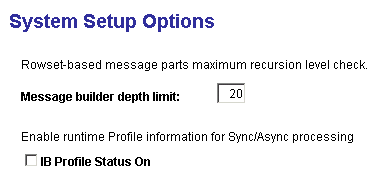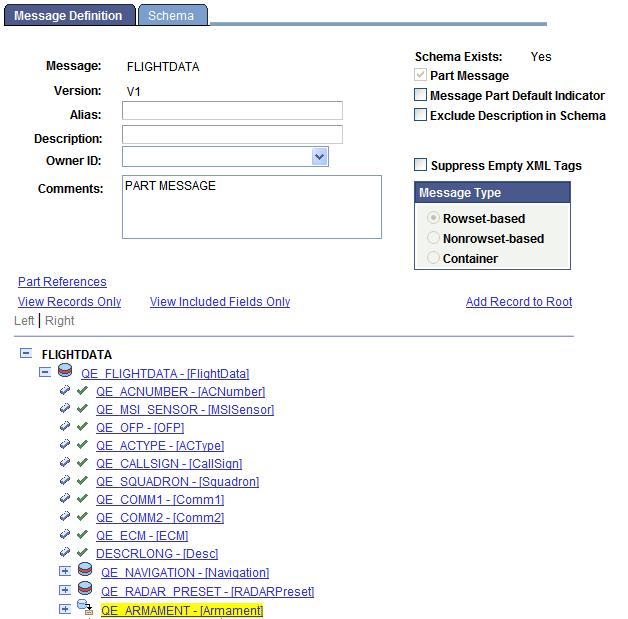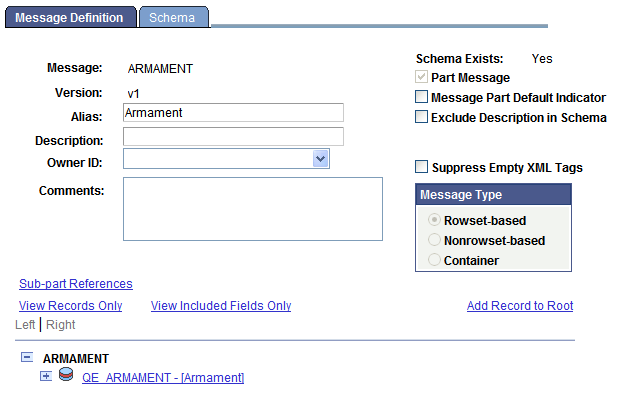Reusing Rowset-Based Message Parts
This section discusses how to:
Reuse rowset-based message parts by reference.
Reuse rowset-based message parts by copy.
PeopleSoft Integration Broker enables you to reuse rowset-based message parts by referencing another message part or by copying another message part.
Note: You cannot reuse message parts at Level 0.
Referencing Message Parts
A reference to a message part is read-only in the message part where it is referenced. To make changes to a referenced message part, you must make the changes to the referenced message part directly. All changes are then propagated to every message in which the message part is referenced.
Copying Message Parts
If you copy a message part, the system copies all records and fields and displays them at the record level. The records and fields become permanent to the new message and you can edit all records and fields directly in the message where the copied part exists. Changes you make to a copied message part are not propagated to other copies of the message part that may exist. You must make changes to a copied message part, you do so manually to each message part that you want to change.
This section discusses how to:
Reuse a message part by reference.
Check for recursion.
View referenced message part information.
View where message parts are referenced.
Modify referenced message parts.
Delete referenced message parts.
Reusing a Message Part by Reference
To reuse a message part by reference:
Create a rowset-based message part.
Add records to the message part per your requirements. At a minimum, you must add a Level 0 record.
In the tree view of the message part definition, click the name of the record off of which to add the reused message part.
The Message Record Properties page appears.
In the Action box, click Add Part Reference.
Identify if the message part is a peer part reference or a child part reference.
If you are working off the Level 0 record, these fields are read only and Child Part Reference is selected by default.
In the Reference Message Version field, click the Lookup button to select the message that the system should reference.
Click the OK button.
The Messages-Message Definition page appears.
The reference part is identifiable in the tree view for the message part definition by the highlighted color on the root record of the referenced part. Since this is a reference, you can only view the reference part data structure. To make any modifications to the referenced part, you must open the message part directly and make your changes there. The system will propagate the changes to all messages that reference the message part.
Checking for Recursion
By default, the system checks up to 20 levels for recursion to ensure that no message part references itself. You can modify this setting to check for recursion in as few as three levels of records and as many as 50 levels.
This parameter is set on the System Setup Options page (IB_SYSTEMSETUP).
This example illustrates the System Setup Options page.

To modify the recursion checking level:
Access the System Setup Options page (select )
In the Message Builder Depth Limit field, enter a value between 3 and 50.
Click the Save button.
Viewing Referenced Message Part Information
A referenced message part appears highlighted in the tree structure for a message in the Messages – Message Definition page.
This example illustrates the Messages – Message Definition page. In the example the message structure for the FLIGHTDATA message is shown. In the tree structure the message record QE_ARMAMENT is highlighted and is therefore a referenced message part in the FLIGHTDATA message.

Note: You can make changes to a message part that is referenced in another part or subpart, as long as the message part is not in the runtime tables, has not been exported as WSDL, or is a restricted message.
If you click a referenced message part, the Part Reference page (IB_MESSAGE_PARTS2) appears.
This example illustrates the Part Reference page.

You can use the Part Reference page to view general information about the referenced message part as well as view the complete definition for the message part.
You can also use this page to delete the reference to the message part. Deleting a part reference is discussed elsewhere in this section.
See Reusing Rowset-Based Message Parts
To view the complete message definition for a referenced message part, on the Part References page View Definition link shown in the previous example. When you click the link the definition for the referenced message part appears in the Messages – Message Definition page.
This example illustrates the Messages – Message Definition page. The example shows the message definition for he Armament message part.

You can use the page to view details about the record structure, view the generated message schema, and so on.
Modifying Referenced Message Parts
To make a modification to a referenced message part, you must make the modification in the message part definition itself. You cannot modify a referenced message part from a message in which it is referenced.
Deleting Referenced Message Parts
You delete a referenced message part in the message where the part is referenced.
To delete a referenced message part:
Open the message definition that contains the referenced message part to delete.
In the tree structure view of the message definition, click the name of the referenced message part to delete.
The Part Reference page appears.
Select the Delete Part Reference check box.
Click the OK button.